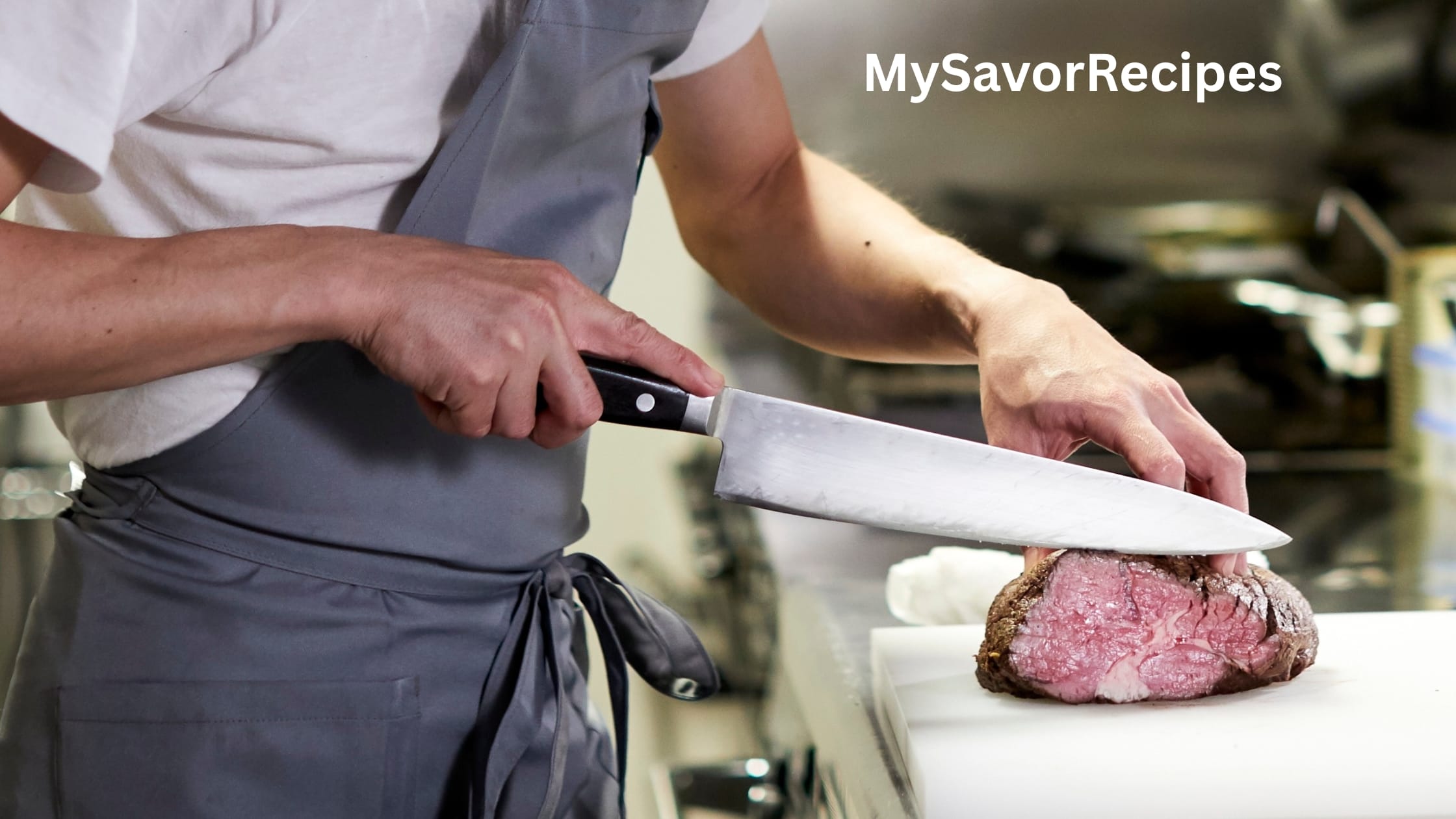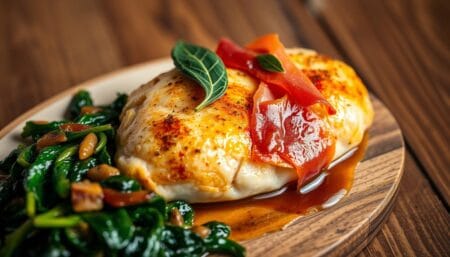Imagine a family gathering where everyone’s eyes light up when you bring out a perfectly cooked roast beef tenderloin. The aroma fills the room, making everyone excited for a special meal. Gourmet roast beef tenderloin is more than just a dish. It turns any occasion into a memorable event.
Whether it’s a small dinner or a big family feast, roast beef tenderloin is perfect. It’s the best cut of beef, offering tender meat and rich flavor. It will impress even the pickiest eaters.
In this guide, you’ll learn how to make a roast beef tenderloin that will wow your guests. We’ll cover everything from picking the right cut to cooking techniques. You’ll be able to create a meal that everyone will remember.
Table of Contents
Key Takeaways
- Roast beef tenderloin is versatile for multiple dining occasions
- The cut offers exceptional tenderness and flavor
- Proper preparation transforms a good meal into a great experience
- Cooking techniques are crucial for achieving perfect results
- Gourmet roast beef tenderloin impresses guests and family alike
Understanding the Premium Cut: What Makes Beef Tenderloin Special
Beef tenderloin is the top choice for chefs and home cooks. It’s known for its high quality. Exploring this cut reveals why it’s a favorite in fine dining.
Choosing a tender roast beef tenderloin requires knowing its special traits. It comes from the cow’s short loin, where the muscle doesn’t move much. This results in a soft, juicy roast that’s a delight to eat.
Different Grades of Beef Tenderloin
Beef tenderloin quality changes with grading. The USDA has three main grades:
- Prime Grade: The highest quality with lots of marbling
- Choice Grade: Excellent quality with some marbling
- Select Grade: Leaner with less fat
Anatomy of the Perfect Cut
The tenderloin muscle is by the cow’s spine. It’s not used much, making it very tender. Chefs remove fat and silver skin to show off the meat.
Why Tenderloin Commands Premium Prices
Several things make beef tenderloin expensive:
- It’s a small cut, usually 2-3 pounds
- It’s very tender
- It has little muscle
- It’s in high demand for restaurants and events
Choosing a high-quality tenderloin means you’re getting a special dining experience. Every slice is a moment of culinary joy.
Essential Equipment and Ingredients for Roast Beef Tenderloin
To make the best roast beef tenderloin, you need the right tools and ingredients. The quality of your equipment and seasonings can make a big difference. This is key to bringing out the best in this premium meat.
For the perfect roast beef tenderloin seasoning, gather essential tools and ingredients. These will turn an ordinary cut into a truly special meal.
Must-Have Kitchen Equipment
- Reliable meat thermometer for precise temperature monitoring
- Large roasting pan with rack
- Sharp kitchen knife for trimming
- Kitchen twine for securing the tenderloin
- Cutting board with non-slip surface
Key Ingredients for Perfect Seasoning
Your seasoning choice is crucial for the dish. Here are some top ingredients:
- Kosher salt – for deep flavor penetration
- Freshly ground black pepper
- Garlic powder
- Dried thyme
- Olive oil or butter for moisture
Professional chefs say to use high-quality sea salt and fresh spices. The right tools and ingredients will make your roast beef tenderloin taste like it’s from a restaurant.
“Great cooking is about precision and passion” – Professional Chef’s Wisdom
Quality is important. Choose fresh herbs, premium spices, and well-kept kitchen tools. This will ensure your roast beef tenderloin is always amazing.
Preparing Your Tenderloin for the Perfect Roast
Cooking roast beef tenderloin needs careful prep for a delicious dish. The right steps can turn a great cut into a memorable meal. Let’s explore the key steps to make your roast beef tenderloin stand out.
Trimming and Tying Techniques
Start with expert trimming. Your roast beef tenderloin cooking tips begin with removing the silver skin and excess fat. Use a sharp knife to carefully cut away the thin, silvery membrane that can make the meat tough.
- Remove silver skin with smooth, precise cuts
- Trim excess external fat, leaving a thin layer for flavor
- Use butcher’s twine to tie the roast at 1-inch intervals
Seasoning Methods and Marinades
Seasoning is key for rich flavors in your roast beef tenderloin. Make a strong seasoning blend that enhances the meat’s natural taste.
| Seasoning Type | Key Ingredients | Best Used With |
|---|---|---|
| Classic Herb Rub | Rosemary, Thyme, Garlic Powder | Traditional Roasts |
| Pepper Crust | Coarse Black Pepper, Sea Salt | Bold Flavor Profiles |
| Mustard Marinade | Dijon Mustard, Olive Oil, Herbs | Tangy Undertones |
Room Temperature Tips
One key tip for roast beef tenderloin is to let it reach room temperature before roasting. Remove the tenderloin from the refrigerator 45-60 minutes before cooking. This ensures even cooking and prevents the outside from burning while the inside stays raw.
- Keep meat covered while reaching room temperature
- Place on a clean cutting board
- Avoid leaving at room temperature for more than 2 hours
Master Guide to Cooking Roast Beef Tenderloin

Learning to cook oven-roasted beef tenderloin needs precision and care. The secret to a perfect roast is knowing the right cooking techniques. These methods turn this top-quality cut into a delicious main dish.
Start your cooking journey by getting your oven and meat ready with these key steps:
- Preheat the oven to 425°F (218°C)
- Pat the tenderloin dry with paper towels
- Season generously with kosher salt and black pepper
- Use a roasting pan with a rack for even heat circulation
The cooking method is crucial. Slow and steady wins the race for this delicate cut. Start with high heat for a golden crust, then lower the temperature for even cooking.
Important techniques for your oven-roasted beef tenderloin recipe include:
- Searing the meat before roasting to lock in flavors
- Using a meat thermometer for precise doneness
- Allowing the roast to rest after cooking
- Monitoring internal temperature carefully
Avoid common mistakes that can ruin your tenderloin. Cook at the right temperature, don’t overcrowd the pan, and always let the meat rest before carving. This keeps it juicy.
Pro tip: For the most tender results, aim for medium-rare with an internal temperature of 135°F (57°C).
Temperature Guide and Cooking Times for Different Doneness Levels
Mastering roast beef tenderloin cooking tips is all about temperature and timing. The secret to a juicy roast beef tenderloin is precise heat management and careful monitoring.
Internal Temperature Guidelines
Achieving the perfect doneness is all about the internal temperature. Here are the essential guidelines for your roast beef tenderloin:
| Doneness Level | Internal Temperature | Appearance |
|---|---|---|
| Rare | 125°F | Bright red center |
| Medium Rare | 135°F | Warm red center |
| Medium | 145°F | Pink center |
| Well Done | 160°F | Slight pink center |
Resting Period Importance
After cooking, let your tenderloin rest for 10-15 minutes. This crucial step allows juices to redistribute, making your roast beef tenderloin more tender and flavorful.
Using Meat Thermometers Correctly
- Insert the thermometer into the thickest part of the meat
- Avoid touching bone or fat
- Remove meat from heat 5-10 degrees before target temperature
- Use a digital instant-read thermometer for accuracy
By following these roast beef tenderloin cooking tips, you’ll create a perfectly cooked, juicy roast beef tenderloin every time.
Complementary Sauces and Side Dishes
To make your roast beef tenderloin dinner special, choose the right sauces and sides. These should match the rich taste of this top-quality meat. A fancy roast beef tenderloin needs sides that make it even more delicious.
Classic sauces can turn your meal into something amazing. Here are some tasty choices:
- Béarnaise Sauce: A rich, buttery sauce with tarragon and shallots
- Red Wine Reduction: Deep, concentrated flavor that matches the tenderloin’s richness
- Horseradish Cream: Adds a zesty kick to the meat

For side dishes, pick ones with good textures and tastes. They should make your meal unforgettable:
- Roasted Root Vegetables
- Carrots
- Parsnips
- Brussels sprouts
- Potato Options
- Creamy gratin
- Herb-roasted fingerling potatoes
- Garlic mashed potatoes
- Fresh Salads
- Arugula with shaved Parmesan
- Mixed greens with vinaigrette
Pro tip: For a fancy roast beef dinner, mix one sauce, a starchy side, and a fresh salad. This combo makes for a classy and filling meal.
Serving and Presentation Tips for Your Roast Beef Tenderloin
Creating the best roast beef tenderloin recipe is more than just cooking. It’s about making your dish look amazing and taste great. How you present your roast beef can turn a simple meal into a memorable experience.
Carving Techniques for Perfect Slices
Learning to carve your tenderloin right is key. It makes your slices look elegant and taste perfect. Here’s how to do it:
- Use a sharp, long-bladed carving knife
- Cut against the grain for maximum tenderness
- Slice approximately 1/2 inch thick pieces
- Maintain consistent angle and pressure
Elegant Plating Strategies
How you plate your meal can make it special. Here are some ideas for your roast beef tenderloin:
| Presentation Style | Recommended Occasions |
|---|---|
| Cascading Slices | Formal dinner parties |
| Family-Style Platter | Casual family gatherings |
| Individual Plated Portions | Sophisticated events |
Creative Garnishing Ideas
Make your roast beef tenderloin stand out with creative garnishes. They add color, texture, and flavor:
- Fresh herb sprigs (rosemary, thyme)
- Edible flowers for an elegant touch
- Colorful vegetable ribbons
- Complementary sauce drizzle
Remember, how your dish looks is just as important as how it tastes. Your tenderloin deserves a presentation that’s as beautiful as its flavor.
Conclusion
Preparing a tender roast beef tenderloin is easier than you think. This guide has shared techniques to make it a top-notch meal at home. Learning about selection, preparation, and cooking makes it special.
Your cooking journey is just starting. Every time you make this dish, you’ll get better. Try new seasonings, cooking ways, and sides to make it yours. Roast beef tenderloin is great for any meal, big or small.
Don’t worry if it’s not perfect the first time. Cooking is all about learning and getting better. Trust yourself and enjoy the tasty outcome. Share your experiences, ask questions, and keep exploring cooking.
Mastering these techniques will make your meals stand out. You’ll impress everyone with your skills. Now, your kitchen is ready to turn simple meat into a masterpiece.




